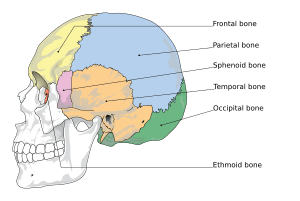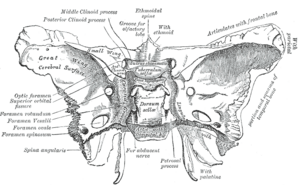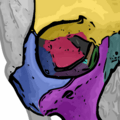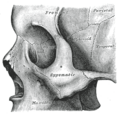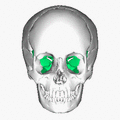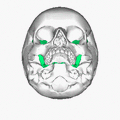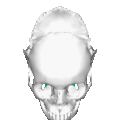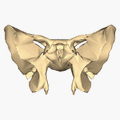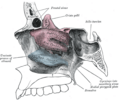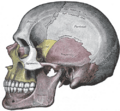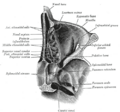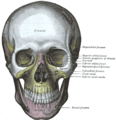Sphenoid bone facts for kids
| Bone: Sphenoid bone | ||
|---|---|---|
| Cranial Bones. Only the end of the wing of the sphenoid bone is visible | ||
| Sphenoid bone, upper surface. | ||
| Latin | os sphenoidale | |
The sphenoid bone is a special bone found in the middle of your skull, right towards the front. It's a single bone, not a pair, and it's super important because it helps connect many other bones in your head. Imagine it like a central piece of a puzzle that holds everything together!
Contents
What is the Sphenoid Bone?
The sphenoid bone is a unique bone in your head. It's often described as looking like a butterfly or a bat with its wings spread out. This bone is a key part of your neurocranium, which is the part of your skull that protects your brain.
Where is the Sphenoid Bone Located?
You can find the sphenoid bone right in the center of your skull. It sits behind your eyes and nose, and it stretches across the width of your head. It's a bit like a bridge connecting the front of your skull to the back.
Why is the Sphenoid Bone Important?
This bone plays a big role in your head!
- Connecting Bones: It connects to many other bones in your skull, like the ones that form your forehead, the sides of your head, and even your jaw.
- Protecting Your Brain: It helps form the base of your skull, giving your brain a safe place to rest.
- Eye Sockets: Parts of the sphenoid bone help create the eye sockets, which are the bony areas that hold and protect your eyeballs.
- Nasal Cavity: It also forms part of the nasal cavity, the space inside your nose that helps you breathe and smell.
- Passageways: The sphenoid bone has several small holes and canals. These are like tunnels for important nerves and blood vessels that go to your eyes, face, and brain.
What Does the Sphenoid Bone Look Like?
The sphenoid bone has several main parts:
- The Body: This is the central part, like the body of the butterfly. It's a cube-shaped section.
- Greater Wings: These are two large, wing-like parts that spread out from the body. They form part of the sides of your skull and the back of your eye sockets.
- Lesser Wings: These are smaller, flatter wings that extend from the front of the body. They form part of the roof of your eye sockets.
- Pterygoid Processes: These are two downward-pointing parts that help form the back of your nasal cavity and are important for some of your chewing muscles.
Images for kids
-
Seen from below (mandible is removed)
-
Seen from above (parietal bones are removed)
See also
 In Spanish: Hueso esfenoides para niños
In Spanish: Hueso esfenoides para niños


